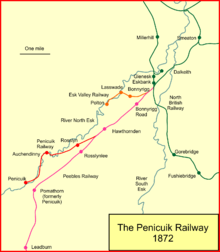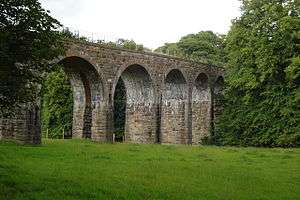Penicuik Railway
| The Penicuik Railway | |||||||||||||||||||||||||||||||||||||||||||||
|---|---|---|---|---|---|---|---|---|---|---|---|---|---|---|---|---|---|---|---|---|---|---|---|---|---|---|---|---|---|---|---|---|---|---|---|---|---|---|---|---|---|---|---|---|---|
| |||||||||||||||||||||||||||||||||||||||||||||
Legend | |||||||||||||||||||||||||||||||||||||||||||||
| |||||||||||||||||||||||||||||||||||||||||||||
The Penicuik Railway was a railway line in Midlothian, Scotland, serving paper mills located on the River North Esk. It opened in 1872 and a substantial residential passenger traffic built up. The line was 4 1/2 miles long.
Passenger usage fell off sharply in the mid-twentieth century and the passenger service was discontinued in 1951. A basic goods train service continued until the line finally closed to all traffic in 1967. There is no railway use of the line nowadays.
History
Before the Penicuik Railway

By 1848 most of the great trunk railways of Scotland had been built, as well as a considerable number of branches. Communities in rural areas found that a railway connection reduced the cost of necessities considerably, and made it cheaper to get local manufactures to market. Conversely places without a railway suffered. The Peebles Railway opened in 1855, transforming the economy of the town. The Peebles Railway ran on high ground well to the east of the River North Esk.
The area around Penicuik itself was found to be rich in minerals, and the Shotts Iron Company established extensive ironstone and coal pits in the locality. The mineral had to be carted to Eskbank station, a considerable inconvenience.
The Caledonian Railway was known to be planning a railway to Penicuik from Slateford, and this alarmed the North British Railway (NBR), which wished to keep the area exclusively under its own control, and keep the rival Caledonian company out. The NBR encouraged the promotion of the Esk Valley Railway, which opened as far as Polton in 1867. The line primarily served paper mills adjacent to the river, and because of the terrain was unsuitable for connecting to the pits.
This left the mining around Penicuik still to be connected, and two independent railways were promoted to connect to the mines: the Edinburgh, Loanhead and Roslin Railway and the Penicuik Railway. The Penicuik line sprang into active promotion in December 1869, causing some friction with the supporters of the Loanhead line, who had been working up their scheme for several years. The NBR agreed to work and maintain the Penicuik line in perpetuity for 45% of gross receipts.[1] Both were nominally independent and sponsored by the NBR, and both obtained Parliamentary authorisation on the same day, 28 June 1870.[note 1][2][3][4]
The Penicuik Railway

The Penicuik Railway obtained its authorising Act on 28 June 1870; the capital was £72,000 for the four mile line.[2][5] The Company's engineer was Thomas Bouch. The terrain was difficult, for the line followed the sinuous River North Esk, which runs between steep hillsides on both sides; the line crossed the River North Esk seven times in two and a half miles, and there was a viaduct and two tunnels. The line left the Peebles Railway at Hawthornden, and there were stations at Rosslyn and Auchendinny as well as Penicuik.[6]
The line opened for goods traffic on 9 May 1872 and to passengers on 2 September 1872.[note 2] Eskbridge station was added on 1 July 1874.[1][2][5][6][7][8]
The Board of Trade Inspecting Officer visited the line on 12 and 19 January 1872 to consider approval for passenger train operation. There was a gunpowder factory at Roslin Glen close to the line, and concern had already been expressed about the danger from sparks from engines, and the Inspecting Officer ordered the Penicuik Company to build a tunnel or other cover for the line at that point. It was formed as a 300 yard long metal tubular structure.[1][8]
Although it was the mineral working around Penicuik which had prompted the idea of the line, in fact it served paper mills primarily; they required copious supplies of water and were located in the valley floor. It was the ELRR, running at a higher level on the west side of the River Esk, which actually connected into the mineral workings.[1]
In 1875 the Shotts Iron Company sank a new shaft at Greenlaw near Glencorse Barracks, and (encouraged by the NBR) the ELRR sought Parliamentary authority to extend the line to serve the mine. This was opposed bitterly by the Penicuik Railway, who saw it as an encroachment. The Penicuik Company had hoped to serve the mine workings but the ELRR line would interpose itself, and be more convenient. Finally the two companies agreed to pool all traffic south of Auchendinny on the Penicuik line and all traffic south of Roslin on the ELRR.[6][8]
Taken over by the North British
The Penicuik Railway was absorbed by the North British Railway, authorised by Act of Parliament of 13 July 1876 and effective on 1 August 1876.[4][5] The North British promised that they would "in all time coming keep up as efficient a passenger train service as at present".[2][9] The Penicuik Railway shares were exchanged at par.[1][4]
The line served several paper mills, and the attractive nature of the area encouraged residential travel by Edinburgh professionals. The line prospered for many years as an outer suburban branch, and for many years the railway was the only practicable means of residential travel to Edinburgh.[7]
Passenger train service
The sixteen mile train journey from Penicuik to Edinburgh took about 40 minutes.
In 1895 there were five Monday to Friday departures, with an additional two on Saturday. In 1922 this had become five plus one, and in 1938 it was five plus three.[10][11][12]
In 1949 the train service had four departures Monday to Friday, five on Saturday.[13]
Closure and current use

Auchendinny station was closed on 5 March 1951, and the branch closed to passenger traffic on 10 September 1951.[6][8]
The last passenger train on the branch was a railtour on 29 August 1964. There were two landslides on the line in 1966, and at that time the only remaining traffic was an occasional goods train to Penicuik. The cost of the rectification considerably exceeded income, and the line was closed to all traffic on 27 March 1967,[7][8][13] and the tracks were quickly lifted.
Part of the line forms a section of the National Cycle Network as route 73.[14]
Topography
It is believed that the main station building at Penicuik dated from the Napoleonic Wars and was used as a kitchen for feeding French prisoners of war.[8]
Locations on the line were:
- Hawthornden Junction; diverging from the Peebles Railway;
- Rosslyn; opened 2 September 1872; renamed Rosslyn Castle 1874; closed 10 September 1951;
- Auchendinny; opened 2 September 1872; closed 5 March 1951;
- Esk Bridge; opened 1 July 1874; soon renamed Eskbridge; occasionally shown as Eskbridge Junction in timetables; closed 1 January 1917; reopened 2 June 1919; closed 22 September 1930;
- Penicuik; opened 2 September 1872; closed 10 September 1951.[8][13][15]
Notes
References
- 1 2 3 4 5 David Ross, The North British Railway: A History, Stenlake Publishing Limited, Catrine, 2014, ISBN 978 1 84033 647 4
- 1 2 3 4 E F Carter, An Historical Geography of the Railways of the British Isles, Cassell, London, 1959
- ↑ Peter Marshall, Peebles Railways, Oakwood Press, Usk, 2005, ISBN 0 85361 638 8
- 1 2 3 John Thomas, The North British Railway, volume 1, David & Charles, Newton Abbot, 1969, ISBN 0 7153 4697 0
- 1 2 3 Christopher Awdry, Encyclopaedia of British Railway Companies, Patrick Stephens Limited, Wellingborough, 1990, ISBN 1 85260 049 7
- 1 2 3 4 John Thomas, Forgotten Railways, Scotland, David and Charles, Newton Abbot, 1976, ISBN 0 7153 7185 1
- 1 2 3 John Thomas revised J S Paterson, A Regional History of the Railways of Great Britain: Volume 6, Scotland, the Lowlands and the Borders, David and Charles, Newton Abbot, 1984, ISBN 0 946537 12 7
- 1 2 3 4 5 6 7 W and E A Munro, Lost Railways of Midlothian, self published by W & E A Munro, 1985
- ↑ Chairman of Penicuik Railway at final Shareholders' Meeting, quoted in Thomas.
- ↑ Bradshaw's General Steam Navigation and Railway Guide, 12th mo, (December) 1895, reprinted by Middleton Press, Midhurst, 2011, ISBN 978 1 908174 11 6
- ↑ Bradshaw's General Railway and Steam Navigation Guide, 7th mo, (July) 1922, reprinted by Guild Publishing, London, 1985
- ↑ Bradshaws July 1938 Railway Guide, David & Charles Publishers, Newton Abbot, 1969, ISBN 0 7153 4686 5
- 1 2 3 Gordon Stansfield, Lost Railways of the Lothians, Stenlake Publishing, Catrine, 2003, ISBN 978 1840 332 704
- ↑ http://www.sustrans.org.uk/assets/files/scotland/Penicuik_to_Dalkeith.pdf
- ↑ M E Quick, Railway Passenger Stations in England Scotland and Wales—A Chronology, The Railway and Canal Historical Society, 2002
External links
- Penicuik station and line history on Disused Stations website
- Line history on RailBrit website
- Images of the line